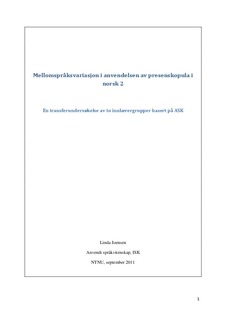| dc.description.abstract | This thesis considers cross linguistic influence (CLI) by using statistic tools as well as the tools proposed by Jarvis and Pavlenko (Jarvis and Pavlenko, 2008) to determine the presence of CLI on a material from the Second Language Corpus /ASK, managed by the University of Bergen. Essays collected from tests of Norwegian as a second language on intermediate (Språkprøven) and higher level (Test i norsk, høyere nivå) provide an ample database of interlanguage, and the thesis looks more closely at the use of the present tense of the copula verb be (være) in the interlanguage of learners whose mother tongue is Russian and Serbo-Croatian (henceforth BCS, Bosnian-Croatian-Serbian). The sample consists of 200 texts per language. By considering intergroup heterogeneity, intragroup homogeneity and cross linguistic performance congruity, it is possible, according to Jarvis and Pavlenko, to positively identify evidence of cross-linguistic transfer. The thesis aims to identify and analyze instances of omitted copula in the Norwegian interlanguage texts by grouping the findings by sentence type and student level. The hypothesis is that BCS learners, having a fully fledged present tense copula in their mother tongue, will show less omission of the copula in their Norwegian interlanguage than Russian learners, who have Ø-copula in the present tense.
The findings of the thesis partially corroborate the hypothesis. Russian learners’ essays contained 60 omitted copulas in the present tense, whereas BCS learners’ essays only had 17. The copula omission was predominantly found in intermediate level texts rather than higher level, and three times more often in Russian learners’ texts than in those of BCS learners’. Statistic tests run on the error frequency data show a significant difference between the two groups. A typological analysis on the examples from the texts, combined with pragmatically direct translation used as a best tertium comparationis, also demonstrate that the omissions made by BCS informants are less obviously simple omissions, and more often have multiple interpretation possibilities. The Russian informants are more typologically systematic in their omissions.
I also set forth to test the claim made by G. Hagland (G. Hagland, 2005) that higher level copula omission in Norwegian interlanguage is not due to cross linguistic influence, but to the strain of writing complex sentences. The findings show this to be partially true- on higher level the bulk of omissions are found in complex or subordinate clauses, and fewer in simple, independent clauses (48 complex clauses vs.12 simple clauses among Russian informants, 15 cases vs. 2 among BCS informants). However, the significantly higher number of omissions in complex sentences among Russian informants to BCS informants (36 to 8) indicates that the linguistic differences could be exerting some influence. The relative complexity of the context does not account for the latter numbers. The testing of the hypothesis showed a significant, although admittedly not large, difference between the two groups.
My assertion is that Jarvis and Pavlenko’s method, in addition to pragmatically direct translation used as a best tertium comparationis, is adequate for identifying CLI in this context. | nb_NO |
